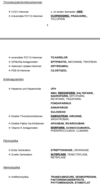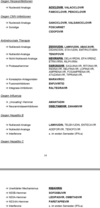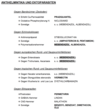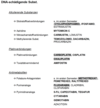Sem2 Flashcards
KV Adrenerges System

RAAS

KV - NO und sonstige

KV- Pharmaka mit Wirkung an Ionenkanälen

Herzinsuffizienz

Antiarrhytmika

Diuretika

Blutbildung

Blutgerinnung

Lipidsenker

Antidiabetika

Einteilung der Erreger
Gram-positive Kokken
Staphylococcus aureus Haut- und Wundinfektionen, Endokarditis
Streptococcus pyogenes Haut-und Wundinfektionen, Scharlach, Tonsillopharyngitis
Streptococcus pneumoniae Atemwegsinfektionen
Streptococcus viridans Karies, Endokarditis, Odontogene Infektionen
Enterkokokken Harnwegsinfektionen, Endocarditis
Gram-positive Stäbchen
Corynebacterium diphteriae Diphterie
Bacillus anthracis Milzbrand
Gram-negative Kokken
Neisseria meningitidis (Meningoc.) Meningitis
Neisseria gonorrhoeae (Gonoc.) Gonorrhoe (Tripper)
Neisseria catarrhalis Atemwegsinfektionen
Gram-negative Stäbchen
Haemophilus influenzae Atemwegsinfektionen
Helicobacter pylori Ulkuskrankheit 9
Coliforme Bakterien Escherichia coli, Klebsiella spp., Proteus spp. – Harnwegsinfektionen
Salmonella spp., Shigella spp. - Diarrhö
Pseudomonas aeruginosa Harn- und Atemwegsinfektionen, Wundinfektionen
Anaerobe Bakterien
Gram-positive Stäbchen Clostridium spp. – C. tetani (Wundstarrkrampf – Tetanus), C. perfringens – Gasbrand, C. botulinum – Botulismus, C. difficile – Pseudomembranöse Colitis
Gram-negative Stäbchen Bacteroides fragilis und andere B. spp. – GIT- und gynäkologische Infektionen
Propionibacterium acnes Akne
Spirochäten
Treponema pallidum Syphilis (Lues)
Borrelia burgdorferi Lyme-Borreliose
Intrazelluläre Bakterien
Legionella pneumophila Legionärskrankheit
Mycoplasma pneumoniae Atemwegsinfektionen
Chlamydia spp. Atemwegsinfektionen, Urethritis
Rickettsien Fleckfieber
Mycobakterien
M. tuberculosis Tuberkulose
M. leprae Lepra
M. avium, M. intracellulare Opportunistische Infektionen
AB Zellwandsynthesehemmer

30s Hemmer

50s Hemmer




















